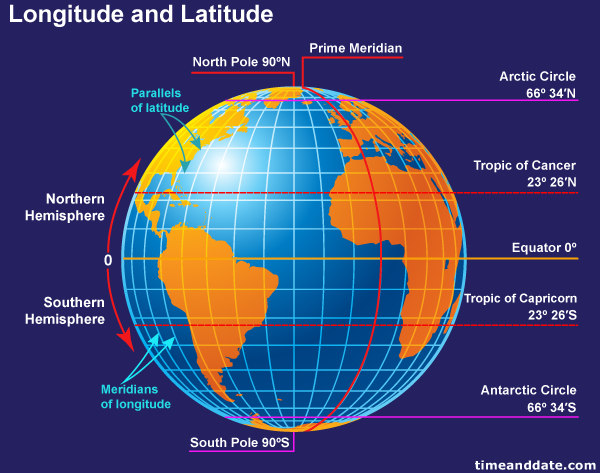
Dear Readers,
Current affairs is an important component of several competitive exams such as the UPSC Civil Services Examination, SSC CGL, Bank PO & PSU entrance tests, etc. Therefore, understanding the terms/concepts/events that make news is critical for aspirants. We at PaGaLGuY bring you series of articles explaining some of these important concepts/events.
In this article we are discussing our Earth’s Latitude & Longitude.
Locations of places on Earth:
To easily calculate exact locations of places on the Earth, imaginary lines have been drawn.
The horizontal lines from east to west that are parallel to the equator are called lines of latitude. The vertical lines from north to south are called lines of longitude. The point where these lines intersect denotes the location of any particular place on Earth.
Latitude:
a) Latitude specifies the north-south position of a point on the Earth. Their position are determined with respect to the equator. The equator represents 0 degrees whereas South and North Poles are 90° S & 90° N respectively.
b) The lines of latitude are drawn at intervals of 1°. For a more precise location, each degree is divided into 60 minutes & each minute into 60 seconds.
c) The most important lines of latitude are equator (0°), Tropic of Cancer (23 ½ °N), Tropic of Capricorn (23 ½ °S), the Arctic Circle (66 ½ °N) & the Antarctic Circle (66 ½ ° S).
d) The equator is called the great circle.
e) The degree of the altitude is little longer on the poles as the poles are flatter than the equator.
f) The Tropic of Cancer divides India into almost two equal parts by passing through 8 states, namely- Gujarat, Rajasthan, Madhya Pradesh, Chhattisgarh, Jharkhand, West Bengal, Tripura & Mizoram.
Longitude:
a) The longitude is an angular distance measured in degrees with respect to the prime meridian.
b) In 1884, the meridian that passes through the Royal Astronomical Observatory at Greenwich near London was chosen as the zero meridian or prime meridian by an international agreement.
c) All other meridians radiate eastwards and westwards from the prime meridian up to 180°. The linear distance between any two longitudes is of 1°. There are in total 360 longitudes on the Earth’s surface.
d) The degree of longitude is longest at the equator and shortest at the poles.
e) The prime meridian at Greenwich is very important to calculate the local time anywhere in the world with respect to G.M.T. or Greenwich Mean Time, also referred to as world time.
f) Africa is the only continent that is intersected by the prime meridian, equator, Tropic of Cancer & Tropic of Capricorn.
g) Antipode is a point opposite to any given point on the Earth’s surface.
Consider, if it is daytime at point X on the Earth, then it is night at its antipode. Also the length of the day at point X is equal to the length of the night at its antipode. So, there is a 12-hour difference between these two points.
Note : Students should study atlas to get a general idea of the countries located on the equator, Tropic of Cancer, Tropic of Capricorn , On 66 ½ ° latitude in Arctic region.
To get fresh updates about different exams on your Facebook & Twitter timelines, subscribe to our pages created specifically for them. We will post only exam specific links on these pages:
Bank PO:
Facebook: https://www.facebook.com/pagalguybankpo
Twitter: https://twitter.com/PaGaLGuYBankPO
SSC – CGL:
Facebook: https://www.pagalguy.com/ssc
Twitter: https://twitter.com/pagalguyssc
UPSC:
Facebook: https://www.facebook.com/pages/Pagalguy-UPSC/951926044840262
Twitter: https://twitter.com/PaGaLGuYUPSC